

|
 |
|||
|
abenaki heritage - readings and lectures - the Boréades of dance |
|||
|
MENAHANEK, ON THE ISLAND
Émilie-Gamelin Park becomes Menahanek, a place for convergence, meetings and exchange, as Montreal Island had been for the First Nations. Sylvain Rivard |
|||
| ÉMILIE-GAMELIN PARK > JUNE 16 - 19 (SAINTE-CATHERINE / BERRI / DE MAISONNEUVE / SAINT-HUBERT, BERRI-UQAM METRO) FROM NOON TO 10 P.M. FROM THURSDAY TO SATURDAY AND FROM NOON TO 5 P.M. ON SUNDAY.
The great Abenaki nation invites Montrealers, visitors from the world over and Aboriginals from the Three Americas to join in with them for these four days of celebrations. A special moment to share in the rich legacy of an ancient culture and the hopes and creativity of communities looking towards the future. Over the years, the First Peoples' Festival outdoor site has become an essential witness to the many facets of the material and spiritual universe of the First Nations. This year, with the colours and voices of the Abenakis, who are its beating heart, the great gathering at Émilie-Gamelin Park will not be a nostalgic re-enactment but a focal point for living forces that make the legacy of traditions a world full of hopes for young generations. |
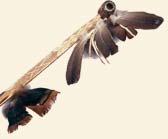 |
||
| MASKS AND BASKETS, PARADOXICAL MEMORIES The First Peoples' Festival outdoor site spotlights the invaluable contribution of First Nations artists and craftspersons is a context that facilitates understanding of the role they play within their communities. Passing a specific technique on to the younger generations is not a nostalgic throwback but a form of resistance to the breakdown of identity. It is far more a statement of faith in the future, as is shown by the constant changes these techniques undergo as they contact modern life. What remains is the vitality of a culture that is proud and rightful to choose to raise its voice in the great choir of humanity. THE UNDERWOOD FAMILY, ABENAKIS FROM NEW ENGLAND Everyone who sees Heather Underwood's red pine needle baskets agrees on the beauty and unique character of each of these works of art. Both in terms of her technique and the care with which long pine needles are rolled together and sewn together with a chain stick, they are the very essence of Aboriginal tradition. Yet these baskets are of African origin. The first slaves around 1700 brought them to America. Not until the early twentieth century did the Abenakis give this art form the degree of perfection that has earned their fame the world over. Heather Underwood gives us a glimpse of this legacy. She is here along with her father Allyn and her mother Rita. Bark work takes the form of light, sturdy canoes. As for woodwork, it takes on strange war clubs shapes whose beauty does not make them any less ominous. MEETING THE BORUCAS, MASKS AND IMAGES WITH THE DEVIL'S OWN CHILDREN — The Borucas are descendants of the Mayas who live in the mountainous south of Costa Rica. The Boruca people have relied largely on passing down traditional craft techniques and the perpetuation of the Diabolitos festival to safeguard their identity. The men sculpt the multicoloured masks in balsa wood. The carved and painted faces bear symbolic representations of nature above the skull. The women take charge of the costumes and prepare the natural pigments used in the painting. The Boruca artists will bring the preparations for the Diabolitos to life through the objects they make for it. THE BULL DIES AND THE NATIVE LIVES — Men, most of them young, hide behind their masks and put on a disguise of jute canvas and palm fronds. For three days and three nights, they mime a pitched battle against the Spanish Conquistadors, symbolised by the bull. They circle the village nine times. In each house, there are tamales and chiéha (corn alcohol). The celebration concludes with the cremation of the conquered bull whose remains are shared among all the Boruca inhabitants. The Diabolitos — little devils —are the Natives who have carried the day. A great fire celebrates the victory and announces a ball that will last all night. The Diabolitos festival takes place every year from December 30 to January 1st. |
|
||
|
NAMING TERRITORIES, TOPONYMY AND IDENTITY
WICKIUP SPACE, EMILIE-GAMELIN PARK > JUNE 16, 17 AND 18 AT 6:30 P.M.
|
|||
| WICKIUP SPACE, EMILIE-GAMELIN PARK > THURSDAY, JUNE 16 AND FRIDAY 17 AT 2:30 P.M. SUNDAY JUNE 19 AT 1:30 P.M. GRANDE BIBLIOTHÈQUE, ROOM M450 > THURSDAY JUNE 16 AND FRIDAY 17 AT 5 P.M. SUNDAY JUNE 19 AT 3:30 P.M.
Words like flames to melt the leaden silence. JUNE 16 Legends are a veritable moral code for the Innu, conveying lessons on how to behave in society. With La Forêt vive (The Living Forest) his most recent work published by éditions Boréal, Rémi Savard proposes to relive the birth of the world through four tales recorded during summer 1970 at La Romaine. He presents the adventures of Tshakapesh and the Algonquian humanism permeating these stories. This humanism is sorely lacking in our contemporary world. Marie-Jeanne Basile will present the Innu language version of these stories. JUNE 17 Maurizio Gatti was born in Italy and lives in Québec since 1998. Geneviève McKenzie will read from Mr Gatti's book accompanied by flutist Victor Falardeau. JUNE 19 From her childhood on, Rae Marie Taylor developed a real affinity with Aboriginal culture in her country of origin, the US Southwest. As she continued her own artistic and poetic explorations, Rae also met First Nations authors including N. Scott Momaday, Linda Hogan, Lucie Tapahonso and Joy Harjo. A recognised specialist in Southwestern art and archaeology, she is highly appreciated as a lecturer and guide. During the 1990s, she launched the first Amerindian literature course at Dawson College. Here she will be reading a selection of texts and reflecting on the major themes of this literature she loves so much. Mi'kmaq actor and storyteller Bob Bourdon will provide authors' words a body and voice. Three fine opportunities to hear these voices from many origins, the wisdom legends pass on to us and these new voices that seek out the beating heart of life by means of words and phrases. N.B.: Lectures are given in french. |
 Rémy Savard
|
||
|
ENCHANTED DUSKS
EMILIE-GAMELIN PARK, UNDER THE PROSPECTOR'S TENTS > TALES AND LEGENDS Words combine with breathing, gestures and the drumbeat to enable all metamorphoses. The storyteller's hand becomes a bird, his gaze a vast plain and his hair the flowing rivers. On the canvas of the tents, shadows and lights are at play and grow longer, alluding to many forms of life. Three large tents welcome the spectators. Two women and one man, storytellers all, concoct the ingredients for a sumptuous banquet. Marge Bruchac, an Abenaki from New England, accompanies her traditional tales with the drumbeat (in English). Nicole O'Bomsawin, director of the Abenakis Museum has devoted her lifelong fire and passion to expressing her people's chants and legends (in French). Dominique T8aminik Rankin, a veteran storyteller and facilitator, is our guide to the symbolic territory of the Anishinabe (in French). These tales and legends are told simultaneously and continuously in the tents. The spectators are invited to move about between them to create their own tales as they cross these travels outside time. An occasion one could dream of to ride upon the wind in good company. |
|||
| EMILIE-GAMELIN PARK > SATURDAY, JUNE 18, 1:30 P.M.
FIRST PEOPLES' FESTIVAL KEYNOTE EVENT FOR THE ENTIRE FAMILY Massed around the stage in the colours of Turtle Island, representation of the earth in Iroquois mythology, people of all ages and origins will be carried away by the many powerful rhythms accompanying the dancers. The dance troupes, from many different traditions, will display their best finery. Their dances often update rituals and celebrations that have marked the seasons of First Peoples. But their effect on the enchanted spectators is authentic and falls squarely within our time frame. The stage is at the centre of the circle of the universe, a setting for loves, births and harvests. The drums announce the coming storm or the hunting seasons. Breaths mix with the sounds of the instruments bequeathed by friendly spirits. Dancing is living to celebrate life. THUNDER HAWKS DANCERS — Thunder Hawks Dancers from Kahnawake allow us to learn of the rich musical heritage and Iroquois dances of the Longhouse. Their programme is made up of traditional social dances such as the welcoming dance, the peace pipe ceremonial dance and the fabulous smoke dance. AWÔSSISAK AKIK — Awôssisak Akik means The Children of the Earth. This group of young Abenaki adults from Odanak was formed to showcase the songs of the Abenaki Nation. Their dances are at once sober and respectful perpetuating ancient chants to the sound of the drums and rattles during ceremonies, social encounters and shows. ALNÔBAK — ALNÔBAK, the Indians in Abenaki, is made up of nine members of the Abenaki communities of Odanak, Wõlinak and New England. The blanket dance marks the initiatory rite for teenaged girls becoming women and the grass snake dance is performed during gatherings to expel evil spirits. The Abenaki or people of the rising sun venerated the morning star and expressed this worship in their dances. ANDICHA N'DE WENDAT — Four Wendake women give a heartfelt rendition of their traditional songs, while the dancers steps resonate to the beat of the drum. For more than three years the members of ANDICHA N'DE WENDAT, have enabled the world to discover the Huron-Wendat culture. This teaching is part of the healing mission of the SACRED CHIEF DRUM. ARMONÍA ANDINA, MUSIC AND DANCE — The Turkuy is a dance originating in Cuzco, in which the men declare their love by the way they dance. On every New Year's Day, the current and former mayors of the province of Canas join together with their wives. The red and white of their costumes recall the colours of pink flamingos, that cross the village skies during their migration. In this dance, the mayors imitate the flamingo chicks, called Turkuy. KISIS — Kisis is a brand new troupe visiting us from Pikogan. We wish them long life. Fancy dancing was invented to entertain visitors to Oklahoma reservations in the 1920s. The dances and the ceremonies they were a part of were not performed before the general public. The dances were originally known as crazy dances because of the dancers' rapid movements and their flamboyant costumes, bedecked with feathers, ribbons and beads. This style of dance is not typical of any specific nation. It is practised nowadays throughout North America. KOLLASUYO FOLK BALLET — Kollasuyo is the ancestral name of Bolivia, a country that encompasses three different geographical regions. They are home to the Aymara, Quechua and Tupiguarani peoples. The Kollasuyo folk ballet, founded in Montreal in 1983, is an opportunity for young people to stay in touch with their ancestors' culture. The Quechua word TINKU means encounter, union or convergence. During this dance, the men wear the montera, a leather helmet recalling the Conquistadors' iron helmets, often decorated with coloured feathers. The women wear a long costume and hats decorated with pompoms, feathers and mirrors. This is the moment of the year when all the negative energies accumulated over a long period are let loose in order to restore balance in daily life. By symbolically letting blood for the Pachamama (Mother Earth), the dancers hope to obtain bountiful harvests for the entire community in return. MEXICO-MAGICO — MEXICO-MAGICO was founded in Montreal in 1990. It presents the best-known dances in Mexican culture and a chance to discover the folklore of the different regions of this country with its age-old traditions. Conceros is a religious and ritual dance, redolent of processions in the honour of the gods. It is typical of Mexico's past and present. NUEVO AMANECER — The members of the Nuevo Amanecer troupe are of Bolivian origin. Les Tobas is a pre-Hispanic dance that recounts how the Incas conquered the Amazonian frontiers where they took indigenous prisoners and enslaved them. |
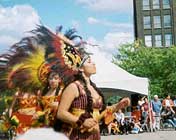 NUEVO AMANECER
|
||
|
BIRDS, TO LIVE AND TO DREAM
Even nowadays, the hunt for wild geese the Cree practise every spring play an essential part in several key aspects of their culture, from the upbringing of the very young do the way they care for their elders. Traditional craft techniques, from the making of birdcalls to the styling of headdresses and clothing, are illustrations of the extent to which the goose and the wild turkey permeate Cree, Mohawk and Abenaki culture. |
|||

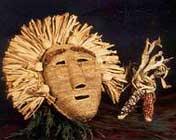
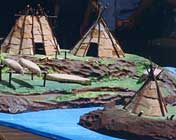
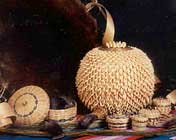
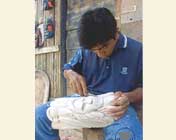
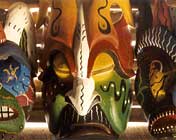
 An overview of Quebec's place names, particularly in the Montreal region. Names coming from First Nations languages open up new perspectives on our history and our understanding of it. The old names bore meanings for the people who had bestowed them on the places they occupied and those they crossed in the course of the seasons. What would those names reveal to us today if we knew them, about the places we inhabit and that inhabit us?
An overview of Quebec's place names, particularly in the Montreal region. Names coming from First Nations languages open up new perspectives on our history and our understanding of it. The old names bore meanings for the people who had bestowed them on the places they occupied and those they crossed in the course of the seasons. What would those names reveal to us today if we knew them, about the places we inhabit and that inhabit us?
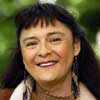

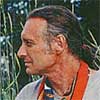
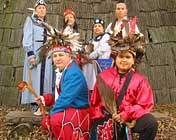
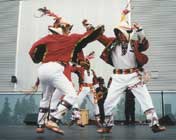
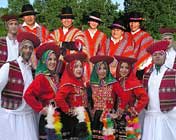
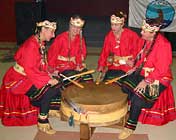
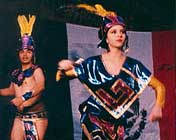
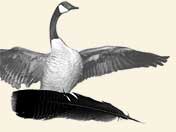 The Canada goose and the wild turkey, recently reintroduced to our forests, are birds of legend. For the First Nations, the legends surrounding these large birds underline their invaluable contribution to the everyday lives of several Aboriginal communities.
The Canada goose and the wild turkey, recently reintroduced to our forests, are birds of legend. For the First Nations, the legends surrounding these large birds underline their invaluable contribution to the everyday lives of several Aboriginal communities.